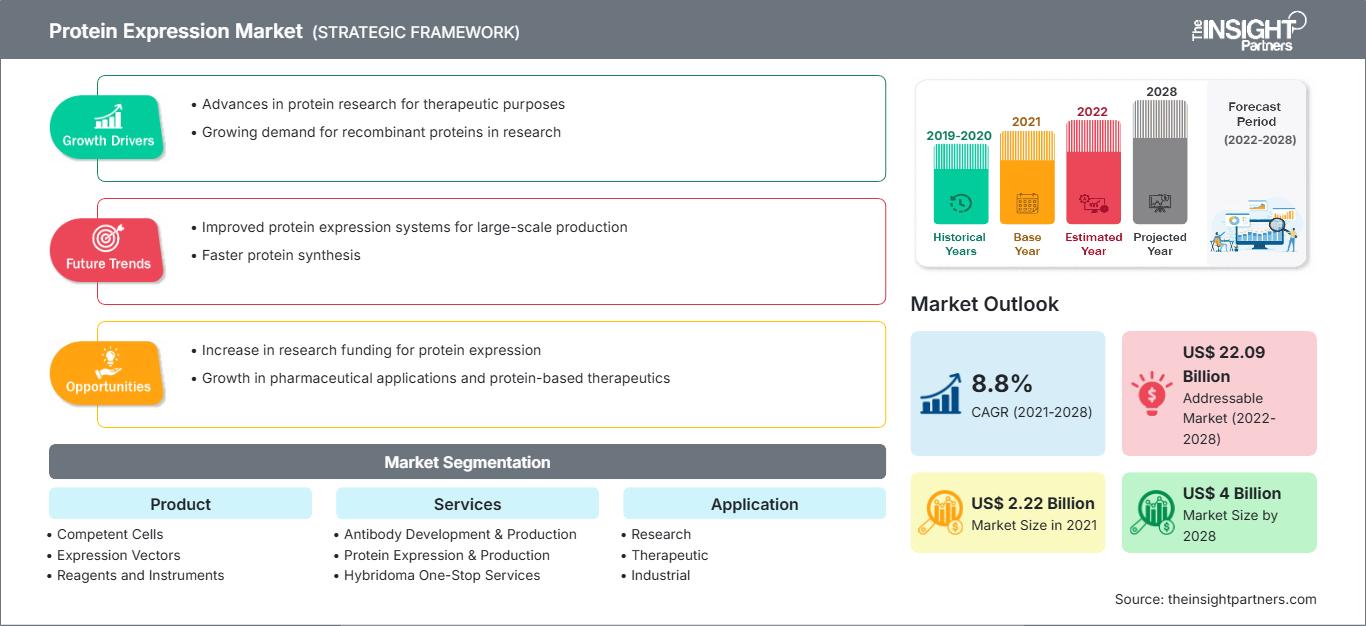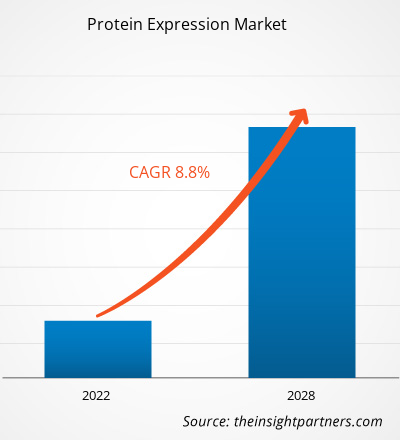Si prevede che il mercato dell'espressione proteica raggiungerà i 4.000,67 milioni di dollari nel 2028, rispetto ai 2.221,73 milioni di dollari del 2021. Si stima che il mercato crescerà con un CAGR dell'8,8% dal 2021 al 2028.
L'ambito del mercato dell'espressione proteica include tipologia di prodotto, servizi, applicazione, utente finale e regione. In base alla regione, il mercato dell'espressione proteica è segmentato in Nord America, Europa, Asia-Pacifico, Medio Oriente e Africa e Sud e Centro America. Il rapporto offre approfondimenti e analisi approfondite del mercato dell'espressione proteica, sottolineando vari parametri come tendenze di mercato, progressi tecnologici, dinamiche di mercato e analisi del panorama competitivo dei principali attori del mercato in tutto il mondo. Include anche un'analisi dell'impatto del COVID-19 nelle diverse regioni.
Approfondimenti di mercato: crescenti applicazioni dell'espressione proteica
L'espressione proteica, uno strumento fondamentale nella ricerca biologica, è sempre più essenziale come meccanismo di produzione farmaceutica per terapie biologiche. La combinazione di vecchie tecnologie, come gli enzimi artificiali, e nuovi sistemi di espressione di nuova generazione sta rivitalizzando i protocolli di espressione proteica. Lo sviluppo dell'ingegneria genetica e della clonazione ha aperto molte possibilità per l'espressione e l'isolamento di proteine eterologhe a scopo di ricerca. Notevoli progressi tecnologici hanno consentito l'espressione e l'isolamento di proteine ricombinanti su larga scala.
La domanda di proteine ricombinanti per applicazioni umane è in aumento di giorno in giorno. Vi è un'enorme richiesta di strategie di bioprocessing innovative e migliorate, che siano convenienti e facciano risparmiare tempo. Il continuo miglioramento dei sistemi di espressione biofarmaceutica ha portato alla produzione di prodotti di qualità. Le moderne tecniche di biologia molecolare sono all'avanguardia nella produzione di proteine biofarmaceutiche utilizzando vari sistemi di espressione procarioti o eucarioti. Diverse tecniche innovative, come la biologia dei sistemi, l'ingegneria metabolica e i sistemi CRISPR/Cas, possono essere applicate all'ingegneria dei ceppi per migliorare le prestazioni dei bioprocessi e generare proteine biologicamente attive e stabili.
Personalizza questo rapporto in base alle tue esigenze
Potrai personalizzare gratuitamente qualsiasi rapporto, comprese parti di questo rapporto, o analisi a livello di paese, pacchetto dati Excel, oltre a usufruire di grandi offerte e sconti per start-up e università
Mercato dell'espressione proteica: Approfondimenti strategici

-
Ottieni le principali tendenze chiave del mercato di questo rapporto.Questo campione GRATUITO includerà l'analisi dei dati, che vanno dalle tendenze di mercato alle stime e alle previsioni.
L'incidenza globale della dengue sta aumentando rapidamente e continuerà fino allo sviluppo di un vaccino efficace contro di essa. Diversi candidati vaccini contro la dengue sono in fase di sviluppo preclinico e clinico, basati su diversi approcci. Alcuni vaccini sono un virus tetravalente vivo attenuato, un virus purificato inattivato, un vaccino a subunità proteica ricombinante, un DNA plasmidico e un vaccino contro la dengue a vettore virale. I recenti progressi sui candidati vaccini contro la dengue basati su subunità ricombinanti, utilizzando vari approcci, come la fusione con altri epitopi immunogenici, l'uso di un nuovo adiuvante, l'espressione proteica in diversi sistemi ospiti, un vaccino progettato e lo sviluppo di VLP, stanno aprendo nuove strade per lo sviluppo di un vaccino pienamente efficace contro la dengue.
Attualmente, sono stati segnalati oltre 65 milioni di casi confermati e oltre 1,5 milioni di decessi. La pandemia di COVID-19 ha causato significative crisi sanitarie, sociali ed economiche globali. Lo sviluppo di un vaccino per il COVID-19 è una strategia efficace per controllare l'epidemia. È necessario che il vaccino venga prodotto ad alta velocità e sia facilmente scalabile. Vaccini a base di proteine ricombinanti, vettori virali o acidi nucleici (DNA plasmidico ricombinante e mRNA) devono essere presi in considerazione per ridurre i tempi di produzione. L'uso dell'espressione proteica è in aumento durante lo sviluppo di vaccini grazie ai vantaggi delle proteine ricombinanti, che guidano la crescita del mercato dell'espressione proteica.
Approfondimenti basati sulla tipologia di prodotto
In base alla tipologia di prodotto, il mercato dell'espressione proteica è segmentato in strumenti, reagenti, vettori di espressione e cellule competenti. Il segmento dei reagenti ha detenuto la quota maggiore del mercato nel 2021. Inoltre, si stima che il segmento dei reagenti registrerà il CAGR più elevato del mercato, pari al 9,5%, durante il periodo di previsione.
Approfondimenti basati sui servizi
In base ai servizi, il mercato dell'espressione proteica è segmentato in sviluppo di anticorpi e Produzione, espressione e produzione di proteine, servizi completi per ibridomi, sviluppo di linee cellulari stabili, servizi di analisi bioanalitiche. Il segmento di sviluppo e produzione di anticorpi ha detenuto la quota di mercato maggiore nel 2021. Tuttavia, si stima che lo stesso segmento registrerà il CAGR più elevato del 9,7% nel mercato durante il periodo di previsione.
Approfondimenti basati sulle applicazioni
In base all'applicazione, il mercato dell'espressione proteica è segmentato in ricerca, terapia e industria. Il segmento terapeutico ha detenuto la quota di mercato maggiore nel 2021 e si stima che lo stesso segmento registrerà il CAGR più elevato del 9,4% nel mercato durante il periodo di previsione.Approfondimenti basati sull'utente finale
In base all'utente finale, il mercato dell'espressione proteica è segmentato in aziende farmaceutiche e biotecnologiche, istituti di ricerca accademica e organizzazioni di ricerca a contratto. Il segmento delle aziende farmaceutiche e biotecnologiche ha detenuto la quota maggiore del mercato nel 2021. Si stima inoltre che il segmento registrerà il CAGR più elevato del mercato, pari al 5,6%, durante il periodo di previsione.
Strategie inorganiche come partnership, fusioni e acquisizioni sono comunemente adottate dalle aziende per soddisfare la mutevole domanda dei clienti e mantenere il proprio marchio in tutto il mondo. Gli operatori del mercato che operano nel mercato dell'espressione proteica adottano anche strategie organiche come il lancio e l'espansione di prodotti per ampliare la propria presenza e il proprio portafoglio prodotti a livello mondiale, nonché per soddisfare la crescente domanda.
Approfondimenti regionali sul mercato dell'espressione proteica
Le tendenze regionali e i fattori che influenzano il mercato dell'espressione proteica durante il periodo di previsione sono stati ampiamente spiegati dagli analisti di The Insight Partners. Questa sezione illustra anche i segmenti e la geografia del mercato dell'espressione proteica in Nord America, Europa, Asia-Pacifico, Medio Oriente e Africa, America meridionale e centrale.
Ambito del rapporto sul mercato dell'espressione proteica
| Attributo del rapporto | Dettagli |
|---|---|
| Dimensioni del mercato in 2021 | US$ 2.22 Billion |
| Dimensioni del mercato per 2028 | US$ 4 Billion |
| CAGR globale (2021 - 2028) | 8.8% |
| Dati storici | 2019-2020 |
| Periodo di previsione | 2022-2028 |
| Segmenti coperti |
By Prodotto
|
| Regioni e paesi coperti |
Nord America
|
| Leader di mercato e profili aziendali chiave |
|
Densità degli attori del mercato dell'espressione proteica: comprendere il suo impatto sulle dinamiche aziendali
Il mercato dell'espressione proteica è in rapida crescita, trainato dalla crescente domanda degli utenti finali dovuta a fattori quali l'evoluzione delle preferenze dei consumatori, i progressi tecnologici e una maggiore consapevolezza dei benefici del prodotto. Con l'aumento della domanda, le aziende stanno ampliando la propria offerta, innovando per soddisfare le esigenze dei consumatori e sfruttando le tendenze emergenti, alimentando ulteriormente la crescita del mercato.

- Ottieni il Mercato dell'espressione proteica Panoramica dei principali attori chiave
- Cellule competenti
- Vettori di espressione
- Reagenti
- Strumenti
Per servizi
- Sviluppo e produzione di anticorpi
- Espressione proteica e Produzione
- Servizi completi per l'ibridoma
- Sviluppo di linee cellulari stabili
- Servizi di analisi bioanalitiche
Per applicazione
- Ricerca
- Terapeutica
- Industriale
Per utente finale
- Aziende farmaceutiche e biotecnologiche
- Organizzazioni di ricerca a contratto
- Istituti di ricerca accademica
- Altri
Per area geografica
- Nord America
- Stati Uniti
- Canada
- Messico
- Europa
- Francia
- Germania
- Italia
- Regno Unito
- Spagna
- Resto d'Europa
- Asia Pacifico (APAC)
- Cina
- India
- Corea del Sud
- Giappone
- Australia
- Resto dell'APAC
- Medio Oriente e Asia Africa (MEA)
- Sudafrica
- Arabia Saudita
- Emirati Arabi Uniti
- Resto del MEA
- America del Sud e Centro (SCAM)
- Brasile
- Argentina
- Resto dello SCAM
Profili aziendali
- Thermo Fisher Scientific, Inc.
- GenScript
- Merck KGaA
- Agilent Technologies, Inc.
- Takara Bio Inc.
- Bio-Rad Laboratories, Inc.
- QIAGEN
- New England Biolabs.
- Promega Corporation
- Oxford Expression Technologies Ltd
- Analisi storica (2 anni), anno base, previsione (7 anni) con CAGR
- Analisi PEST e SWOT
- Valore/volume delle dimensioni del mercato - Globale, Regionale, Nazionale
- Industria e panorama competitivo
- Set di dati Excel
Report recenti
Testimonianze
Motivo dell'acquisto
- Processo decisionale informato
- Comprensione delle dinamiche di mercato
- Analisi competitiva
- Analisi dei clienti
- Previsioni di mercato
- Mitigazione del rischio
- Pianificazione strategica
- Giustificazione degli investimenti
- Identificazione dei mercati emergenti
- Miglioramento delle strategie di marketing
- Aumento dell'efficienza operativa
- Allineamento alle tendenze normative






















 Ottieni un campione gratuito per - Mercato dell'espressione proteica
Ottieni un campione gratuito per - Mercato dell'espressione proteica